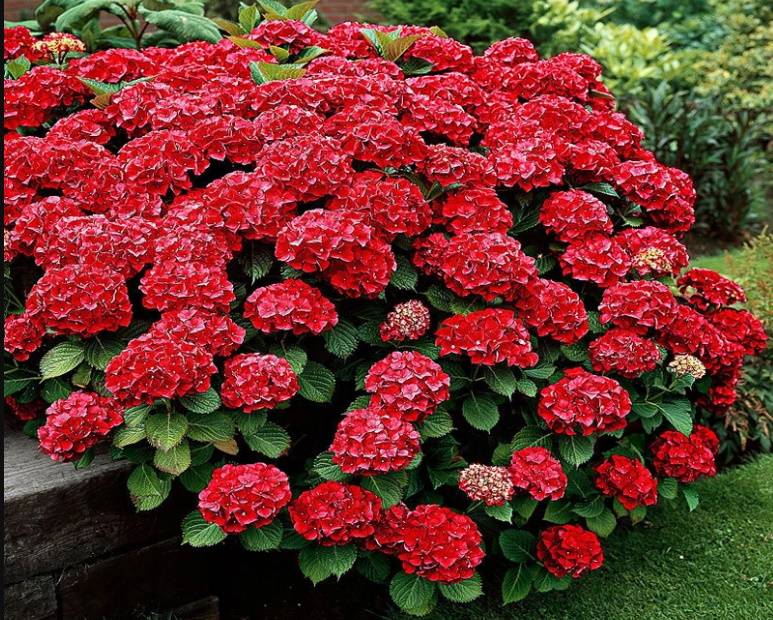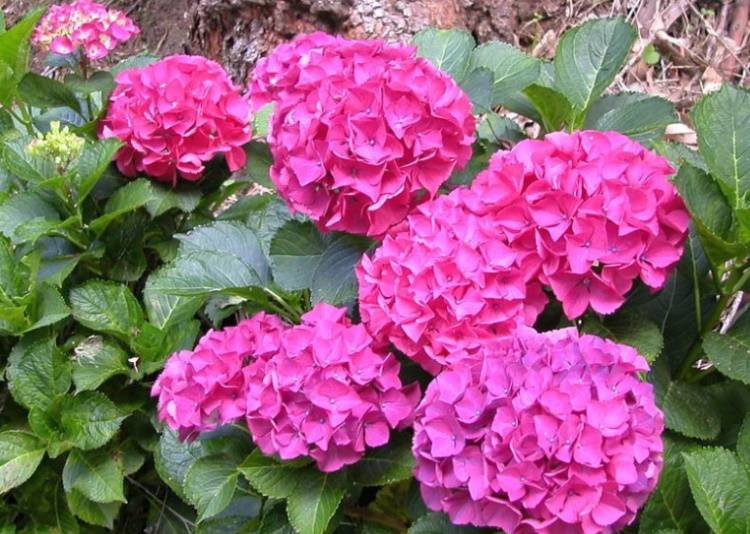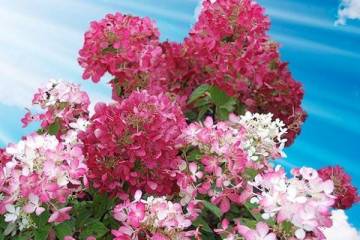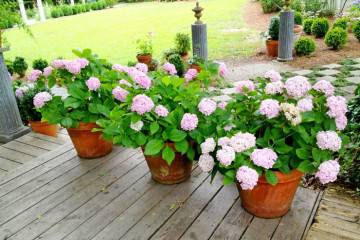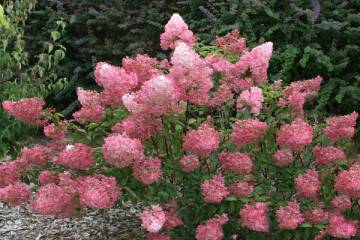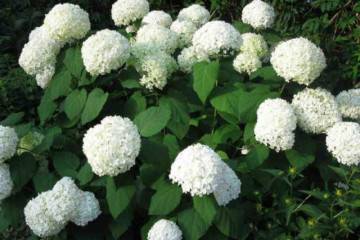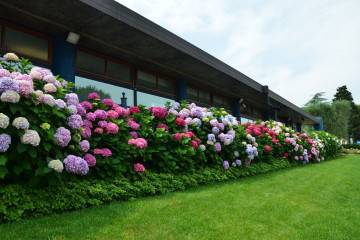Hydrangea red large-leaved Fiery beauty
Content:
The Japanese rose, known in Europe as hydrangea, is called Ajisai by the inhabitants of the Japanese islands. The hieroglyphic record of the name translates as a flower similar to a purple sun. Plants were brought to England almost 3 centuries ago, but they have received worldwide fame only now. In areas with a temperate climate, Hydrangea (hydrangia is the botanical name for adzisai) are grown as deciduous, long-flowering perennials with high decorative qualities.
Types and varieties of red hydrangeas
Over the years of breeding work, the Japanese rose has acquired new colors of flower petals. Chameleon plants were bred, changing the shades of inflorescences depending on the level of acidity of the soil composition. It became a sensation in floriculture. These types of plants include large-leaved fiery red hydrangea.
Large-leaved hydrangeas are classified in a separate group, Hydrángea macrophýlla. In open ground, some of them grow up to 4 meters in height. Most species of Hydrángea macrophýlla are characterized by weak winter hardiness; when grown in the open air, they need shelter from frosts below -18-23 ° C.
Flower buds of large-leaved hydrangeas, in contrast to paniculate and tree-like hydrangeas, are formed on last year's shoots. Very often they are damaged in spring with return frosts and in winter without shelter. The diameter of carmine-red pom-poms in partial shade reaches 15-25 cm. Flowering lasts 2-3 months. Low varieties of large-leaved hydrangeas do well in artificial conditions as houseplants.
Most varieties of large-leaved hydrangeas are decorated with huge sterile flower pom-poms of umbellate inflorescences up to 20 cm in diameter. In fact, the petals of the inflorescences are modified leaves. This was achieved by the breeders. In an effort to increase the size of the flower, they bred varieties that are not capable of forming seeds - without stamens and pistils. The energy of the plants was redirected from generative possibilities to decorative ones.
Hydrangea large-leaved Fiery beauty
The spreading crown of an adult 2-meter bush Hydrangea macrophylla Fiery beauty reaches a diameter of 2 m. Withstands frosts down to -18 ° C. The diameter of the carmine-red pom-poms in partial shade reaches 20 cm. It begins to bloom in July, ends in November.
To maintain the bright red color of the inflorescences, it should be grown on slightly acidic soils that do not contain easily digestible aluminum. If a plot of land with an alkaline reaction is chosen for planting a bush, then the plant, on the contrary, needs to be fed with fertilizers, which include aluminum.
Hydrangea Hot Red
The inflorescences of the Hydrangea macrophylla Hot Red variety are colored in raspberry shades. The size of the flower balls does not exceed 15 cm. The low bushes (up to 1 m) are spherical.
During the season, the plants increase the length of the stem growth by 20 cm. It belongs to the 5th zone of winter hardiness (-18-23 ° C). Blooms from June to September. So that the plant does not change the color of the flowers during the cultivation process, when planting, low peat with a high level of acidity and organic components is added to the garden soil.
Hydrangea Alpengluchen
Bushes Hydrangea macrophylla Alpengluhen tolerate frosts down to -23 ° C. Bloom in July, bloom until October. The height of the bushes is no more than 1.2 m. The diameter of the dark pink inflorescences is up to 25 cm. For normal flowering, they should be in the sun in the morning and evening, in partial shade during the day.
Bushes require protection from unexpected severe frosts as flower buds are laid on green shoots growing from last year's branches. Therefore, during the winter freezing of the bush, there will be no flowering.
Hydrangea Red Baron
The erect stems of large-leaved Hydrangea macrophylla Red Baron adorn not only inflorescences of raspberry-pink shades up to 25 cm in diameter, but also bright green leaves. The height of the bushes is small - up to 60 cm. It is very often used as a pot culture.
In open ground it can be grown in 5-6 zones of frost resistance at temperatures down to -18 ° C. In the trade network Hydrangea macrophylla Red Baron, they sometimes offer a different version of the name - Schoene Bautznerin. In acidic areas of the soil with a high content of aluminum ions, the flowers become purple in color.
Caring for red hydrangeas in the garden
Growing garden blooming, large-leaved hydrangeas can be challenging. Many novice gardeners do not take into account the main feature of this type of Hydrangea - the formation of buds occurs on flowering shoots growing on the tops of the stems that have grown in the past year. Therefore, planting, pruning bushes, and sheltering Hydrangea macrophylla have certain rules that are different from the same rules for other types of hydrangeas.
Place of cultivation
Choose a shaded place, sheltered from the wind and located on the east or north side of the site. Such a choice will help to slow down the development of flower buds in the spring in order to prevent them from freezing in the event of spring frosts. In the southern and western areas, the heating of the soil and air occurs faster than in the eastern and northern areas, so the kidneys begin to wake up earlier and die from the return cold.
Soil composition
Hydrangeas are grown on fertile clay lands with a weak acidity level.
For planting a young bush of hydrangea, a substrate is prepared from humus, leafy soil, bottom peat (1: 1: 1). Add 1.5 tbsp to the planting pit. l. urea, 2 tbsp. l. potassium, 4 tbsp. l. superphosphate.
Top dressing
Hydrangea macrophylla bushes, planted in prepared fertile soil, do not feed for 2-3 years. A sign that the soil is depleted will be insufficient growth of stem mass, a decrease in the size of buds, and a lightening of the shade of the leaves.
The first feeding is carried out in early spring on wet soil after the ground has warmed up. A complex is used, which includes nitrogen (urea), superphosphate, potassium (2: 1: 0.5). Organic matter is added to mineral fertilizers - an aqueous solution of rotted manure (1 liter per 10 liters of water). After 2 weeks, feeding with organic fertilizers can be repeated. Use an infusion of poultry droppings - 0.5 liters per 10 liters of water.
During budding, a mixture of 3 tbsp is used. l. superphosphate and 2 tbsp. l. potassium sulfate dissolved in 10 liters. water. Hydrangea has long flowering periods, so this fertilizer composition is used one more time.
Watering
Hydrangeas, with their abundant flowering, need a lot of water. But moisture should not spread over the surface of the near-trunk circle of the bush and immediately evaporate from the heat and wind. Therefore, when watering, the following rules should be observed:
- Watering is carried out early in the morning or in the evening after sunset.
- Use settled tap or spring water heated to ambient temperature.
- Watering should be rare, but abundant - at least 10-20 liters per bush, depending on the size of the plant.
- If necessary, the water is acidified. In 10 liters of water, dissolve 0.5 g of citric acid or 2 tbsp. table vinegar.
In the heat, the frequency of watering is increased; in rainy weather, they are guided by the state of the soil in the root zone.
Features of care during flowering
The active flowering of hydrangeas depends on the location of the bush, successful wintering, soil fertility, regularity and abundance of watering. In order for moisture to penetrate to the entire root system of shrubs, deep drip irrigation or mulching of the soil around the bush is used. Mulch protects roots from drying out, soil from cracking. Coniferous litter is used.
Preparing for winter
Do not prune Hydrangea macrophylla after flowering. Some growers do not even remove faded inflorescences so as not to damage the tops of the stems, but the leaves are always pruned. It is possible not to cut the hydrangea only in those regions where plants are not sheltered from the cold in winter. In the northern regions, it is impossible to do without removing the inflorescences.
A frame is installed above the hydrangea bush, the stems are neatly tied in several bundles, covered with coniferous spruce branches, covered with agrofibre and plastic wrap.
Features of care during the rest period
Hydrangea bushes should not leave dry roots in winter. If there is no rain in the fall, 2 weeks before frost, the plants are watered abundantly with the addition of superphosphate. In rainy weather, fertilizer granules are scattered over the soil surface under the bushes. Plants that grew in the open air in large pots or barrels are lowered into a basement with an air temperature of +5 ° C to + 10 ° C. Periodically, the soil in the containers is moistened.
Selective pruning of large-leaved hydrangeas is carried out in early spring after removing the shelters. Broken and excess stems are removed.
When growing large-leaved hydrangeas, many inexperienced gardeners make mistakes: they carry out a complete pruning of the bushes or remove their shelter after wintering at the wrong time. But they learn from mistakes. If the hydrangea root does not die in frost, then even if not immediately, even in the second or third year of cultivation, this beautiful plant will still bloom near the house or in a container.
